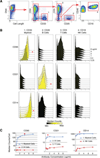Scalable Conjugation and Characterization of Immunoglobulins with Stable Mass Isotope Reporters for Single-Cell Mass Cytometry Analysis
- PMID: 31077099
- PMCID: PMC6687300
- DOI: 10.1007/978-1-4939-9454-0_5
Scalable Conjugation and Characterization of Immunoglobulins with Stable Mass Isotope Reporters for Single-Cell Mass Cytometry Analysis
Abstract
The advent of mass cytometry (CyTOF®) has permitted simultaneous detection of more than 40 antibody parameters at the single-cell level, although a limited number of metal-labeled antibodies are commercially available. Here we present optimized and scalable protocols for conjugation of lanthanide as well as bismuth ions to immunoglobulin (Ig) using a maleimide-functionalized chelating polymer and for characterization of the conjugate. The maleimide functional group is reactive with cysteine sulfhydryl groups generated through partial reduction of the Ig Fc region. Incubation of Ig with polymer pre-loaded with lanthanide ions produces metal-labeled Ig without disrupting antigen specificity. Antibody recovery rates can be determined by UV spectrophotometry and frequently exceeds 60%. Each custom-conjugated antibody is validated using positive and negative cellular control populations and is titrated for optimal staining at concentrations ranging from 0.1 to 10 μg/mL. The preparation of metal-labeled antibodies can be completed in 4.5 h, and titration requires an additional 3-5 h.
Keywords: Antibody; Bismuth; Conjugation; CyTOF; IgG; Immunoglobulin; Isotope; Lanthanide; Mass cytometry; Titration.
Conflict of interest statement
Competing Financial Interests
S.C.B. and E.F.S. have been paid consultants for the company Fluidigm Sciences, the manufacturers that produced some of the reagents and instrumentation described in this manuscript.
Figures



References
Publication types
MeSH terms
Substances
Grants and funding
- R33 CA183654/CA/NCI NIH HHS/United States
- U19 AI100627/AI/NIAID NIH HHS/United States
- R01 HL120724/HL/NHLBI NIH HHS/United States
- U24 CA224331/CA/NCI NIH HHS/United States
- R21 AG057224/AG/NIA NIH HHS/United States
- R33 CA183692/CA/NCI NIH HHS/United States
- R01 CA184968/CA/NCI NIH HHS/United States
- R01 AG056287/AG/NIA NIH HHS/United States
- R01 AG057915/AG/NIA NIH HHS/United States
- U19 AI057229/AI/NIAID NIH HHS/United States
- DP5 OD023056/OD/NIH HHS/United States
- R21 CA183660/CA/NCI NIH HHS/United States
- S10 OD018040/OD/NIH HHS/United States
- U19 AI116484/AI/NIAID NIH HHS/United States
- U54 CA149145/CA/NCI NIH HHS/United States
- R00 GM104148/GM/NIGMS NIH HHS/United States
- DP2 EB024246/EB/NIBIB NIH HHS/United States
- UH2 AR067676/AR/NIAMS NIH HHS/United States
- U24 CA224309/CA/NCI NIH HHS/United States

